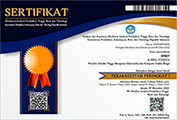PEMANFAATAN METODE NAÃVE BAYES UNTUK DIAGNOSIS TINGKAT STRES PADA MAHASISWA TINGKAT AKHIR BERBASIS DOMAIN EXPERT
Abstract
Stress is something that everyone experiences in general, meaning that stress itself is a change in the body's response to threats and pressure. In dealing with stress, there are two reactions experienced by person, positive reactions and negative reactions. positive reactions can be in the form of better adaptability and increased levels of alertness and can spur these individuals to become more advanced in various matters and fields, besides the positive impact on some individuals stress can cause negative reactions which can be characterized by excessive worry, fear and feeling anxious. In living life as a student who hones knowledge in lectures according to the field taken, stress can hinder the lectures that are being undertaken, stress factors that are generally experienced by students such as bad association and relationships between fellow students or lecturers, lack of trust self, lack of support from family. Based on these problems, the authors feel the need for an expert system design to detect student stress levels with the Naive Bayes Method by taking the test location at Narotama University. The design of this expert system aims to allow students to independently diagnose the level of stress experienced. from this expert system design as much as 90% of students who do the testing get solutions from expert advice as outlined in the design of this application.
Keywords
Full Text:
PDF Hal 74-82References
R. Larasati, “PENGARUH STRES PADA KESEHATAN JARINGAN PERIODONTAL,†J. SKALA HUSADA J. Health, vol. 13, no. 1, Feb 2017, doi: 10.33992/jsh:tjoh.v13i1.86.
V. Subramaniam, “HUBUNGAN ANTARA STRES DAN TEKANAN DARAH TINGGI PADA MAHASISWA,†Intisari Sains Medis, vol. 2, no. 1, hlm. 4–7, Apr 2015, doi: 10.15562/ism.v2i1.74.
M. R. Fahriza dan L. Ulfa, “Faktor Penyebab Stress dan Dampak Bagi Kesehatan,†Open Science Framework, preprint, Jul 2019. doi: 10.31219/osf.io/h4cnv.
N. Asri dan E. S. Lely Octaviana, “Aktivitas Olahraga Di Masa Pandemi COVID-19 Terhadap Tingkat Stres Mahasiswa Pendidikan Olahraga Universitas Islam Kalimantan Muhammad Arsyad Al Banjari Banjarmasin,†Hal. Olahraga Nusant. J. Ilmu Keolahragaan, vol. 4, no. 1, hlm. 53, Jan 2021, doi: 10.31851/hon.v4i1.5213.
Much. F. Saifuddin, “E-Learning dalam Persepsi Mahasiswa,†J. VARIDIKA, vol. 29, no. 2, hlm. 102–109, Jan 2018, doi: 10.23917/varidika.v29i2.5637.
R. Kartika, “ANALISIS FAKTOR MUNCULNYA GEJALA STRES PADA MAHASISWA AKIBAT PEMBELAJARAN JARAK JAUH DI MASA PANDEMI COVID-19,†PsyArXiv, preprint, Des 2020. doi: 10.31234/osf.io/nqesb.
S. Musabiq dan I. Karimah, “Gambaran Stress dan Dampaknya Pada Mahasiswa,†Insight J. Ilm. Psikol., vol. 20, no. 2, hlm. 74, Agu 2018, doi: 10.26486/psikologi.v20i2.240.
H. Fahmi, “Sistem Pakar Mendiagnosa Penyakit Mata KatarakDengan Metode Certainty Factor Berbasis Web,†MATICS, vol. 11, no. 1, hlm. 27, Okt 2019, doi: 10.18860/mat.v11i1.7673.
M. R. Handoko, “SISTEM PAKAR DIAGNOSA PENYAKIT SELAMA KEHAMILAN MENGGUNAKAN METODE NAIVE BAYES BERBASIS WEB,†J. Teknol. Dan Sist. Inf., vol. 2, no. 1.
A. A. Mahran, R. K. Hapsari, dan H. Nugroho, “PENERAPAN NAIVE BAYES GAUSSIAN PADA KLASIFIKASI JENIS JAMUR BERDASARKAN CIRI STATISTIK ORDE PERTAMA,†Netw. Eng. Res. Oper., vol. 5, no. 2, hlm. 91, Okt 2020, doi: 10.21107/nero.v5i2.165.
I. Imron, “Analisa Pengaruh Kualitas Produk Terhadap Kepuasan Konsumen Menggunakan Metode Kuantitatif Pada CV. Meubele Berkah Tangerang,†Indones. J. Softw. Eng. IJSE, vol. 5, no. 1, hlm. 19–28, Jun 2019, doi: 10.31294/ijse.v5i1.5861.
S. E. Zaluchu, “Strategi Penelitian Kualitatif dan Kuantitatif Di Dalam Penelitian Agama,†Evang. J. Teol. Injili Dan Pembin. Warga Jemaat, vol. 4, no. 1, hlm. 28, Jan 2020, doi: 10.46445/ejti.v4i1.167.
M. R. Julianti, M. I. Dzulhaq, dan A. Subroto, “Sistem Informasi Pendataan Alat Tulis Kantor Berbasis Web pada PT Astari Niagara Internasional,†J. SISFOTEK Glob., vol. 9, no. 2, Sep 2019, doi: 10.38101/sisfotek.v9i2.254.
H. Kurniawan, W. Apriliah, I. Kurniawan, dan D. Firmansyah, “Penerapan Metode Waterfall Dalam Perancangan Sistem Informasi Penggajian Pada SMK Bina Karya Karawang,†J. Interkom J. Publ. Ilm. Bid. Teknol. Inf. Dan Komun., vol. 14, no. 4, hlm. 13–23, Jan 2020, doi: 10.35969/interkom.v14i4.58.
H. F. Siregar dan M. Melani, “Perancangan Aplikasi Komik Hadist Berbasis Multimedia,†J. Teknol. Inf., vol. 2, no. 2, hlm. 113, Feb 2019, doi: 10.36294/jurti.v2i2.425.
B. Sudradjat, “Rancang Bangun Sistem Informasi Penjualan Fashion Berbasis Web,†J. Interkom J. Publ. Ilm. Bid. Teknol. Inf. Dan Komun., vol. 13, no. 3, hlm. 22–28, Okt 2018, doi: 10.35969/interkom.v13i3.34.
DOI: http://dx.doi.org/10.53567/spirit.v15i1.276
Refbacks
- There are currently no refbacks.
Copyright (c) 2023 YOSHUA DIMAS MEGANTARA

This work is licensed under a Creative Commons Attribution 4.0 International License.
Diindeks Oleh:
SPIRIT : Sarana Penunjang Informasi Terkini
Diterbitkan oleh Teknologi Informasi Institut Teknologi dan Bisnis Yadika Pasuruan
Alamat Redaksi: Jl. Bader No.9, Kwangsan, Kalirejo, Kec. Bangil, Pasuruan, Jawa Timur 67153
Telp/Fax: (0343) 742070 , Email : lppm@stmik-yadika.ac.id
Google Maps : Klik Disini

Karya ini dilisensikan di bawah Lisensi Internasional Creative Commons Atribusi 4.0 .







1.png)







